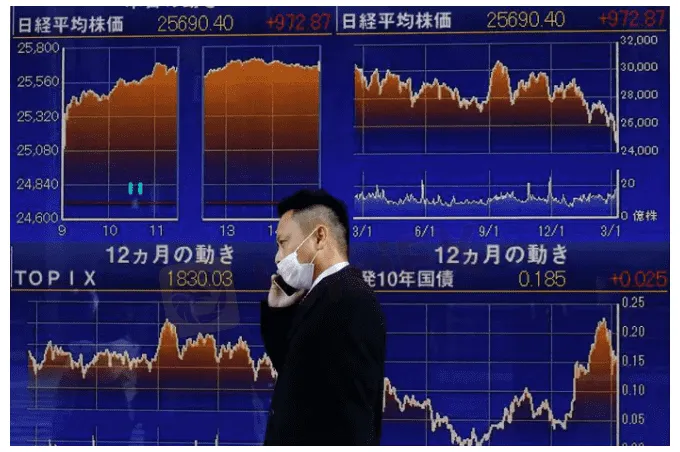简体中文
繁體中文
English
Pусский
日本語
ภาษาไทย
Tiếng Việt
Bahasa Indonesia
Español
हिन्दी
Filippiiniläinen
Français
Deutsch
Português
Türkçe
한국어
العربية
Asia stocks skid as Ukraine war, Chinas COVID surge weigh
Abstract:Asian stocks were in the red on Tuesday as surging COVID-19 cases in China hit the confidence of investors who are already worried about the Ukraine war and the first U.S. interest rate rise in three years, which could come this week.

MSCIs broadest index of Asia-Pacific shares outside Japan was down 1.91%, led by Chinese stocks. The index is down 8.2% so far this month.
Hopes that talks between Russia and Ukraine due to resume on Tuesday could provide a resolution to the conflict prompted a sharp fall in global oil prices.
However, the fourth round of negotiations began Monday with no major progress seen, adding to the nervousness in equity markets.
During the Asian session, U.S. crude slipped a further 2.54% to $100.44 a barrel, in line with broader asset selling. Brent crude was down 2.27% to $104.42 per barrel.
In U.S trading, oil prices had fallen as much as 5.8% as prospects of a positive outcome in Ukraine talks eased concerns about major supply disruptions.
But adding to the overall negative sentiment are rising case numbers of COVID-19 in China, which investors fear will hurt the mainlands economic growth in the first quarter.
“Right now everyone is looking at the Chinese cases and realising that has to have an effect on production,” said Hong Hao, BOCOM Internationals head of research.
“China‘s growth in the first quarter could be closer to zero than 5.5%. There’s a ripple effect. Theres Ukraine, the risk of U.S. sanctions on China and rising Chinese domestic COVID cases – it does not look good.”
Hong Kong‘s Hang Seng Index remains mired in negative territory, dropping 3.8% early on Tuesday, following an almost 5% selloff one day earlier. Hong Kong’s main board is down 17% so far in March.
Chinas CSI300 index was down 2.3%.
China on Tuesday reported 3,602 new confirmed coronavirus cases compared with 1,437 on Monday, according to the National Health Commission.
Investor focus is also on the U.S Federal Reserve, which meets on Wednesday and is expected to hike interest rates for the first time in three years to offset rising inflation.
Australian shares slipped 0.5% while Tokyos Nikkei Index was marginally higher, up 0.17%.
U.S. stocks experienced a mixed session, with declining technology companies prompting most indexes to close lower Monday.
The Dow Jones Industrial Average was mostly flat, the S&P 500 lost 0.74% and the Nasdaq Composite dropped 2.04%.
The yield on the benchmark 10-year Treasury notes rose to 2.1419% compared with its U.S. close of 2.14% on Monday.
The two-year yield, which rises with traders expectations of higher Fed fund rates, touched 1.865%, up from 1.849%.
Gold was also weaker in Asia with the spot price at $1,949.21 per ounce. [GOL/]

Disclaimer:
The views in this article only represent the author's personal views, and do not constitute investment advice on this platform. This platform does not guarantee the accuracy, completeness and timeliness of the information in the article, and will not be liable for any loss caused by the use of or reliance on the information in the article.
Read more

Guide to Trading News Releases & Navigating Market Volatility
Understanding when key news releases occur, identifying the most impactful ones, and effectively trading them while managing risk can set you apart from the competition. This article delves into these aspects, helping you navigate the complexities of trading forex on news releases.

The History of Ponzi Schemes
This article outlines the history of Ponzi schemes, highlighting the infamous Charles Ponzi, Bernie Madoff, and beyond.

Is High leverage Better Than low leverage?
Leverage allows traders to amplify their market exposure beyond their initial investment, making it a pivotal factor in broker selection.

PU Prime Ups Leverage Limit, Downs Stop-out Level
Leading broker PU Prime is shaking things up with a dual approach to enhance customer risk management and trading opportunities. Effective June 17th, 2024.
WikiFX Broker
Latest News
CWG Markets Got FSCA, South Africa Authorisation
Amazon launches Temu and Shein rival with \crazy low\ prices
CySEC Warns Against Unauthorized Investment Firms in Cyprus
JUST Finance and UBX Launch Multi-Currency Stablecoin Exchange
XM Revamps Website with Sleek Design and App Focus
TradingView & Mexico’s Uni. Partnership, to Enhance Financial Education
Something You Need to Know About SogoTrade
Global Shift in Cryptocurrency Taxation: Italy and Denmark Chart New Paths
Webull Introduces 24/5 Overnight Trading to Extend U.S. Market Access
eToro Launches Global-Edge Smart Portfolio: A Balanced Approach to Growth and Stability
Currency Calculator


